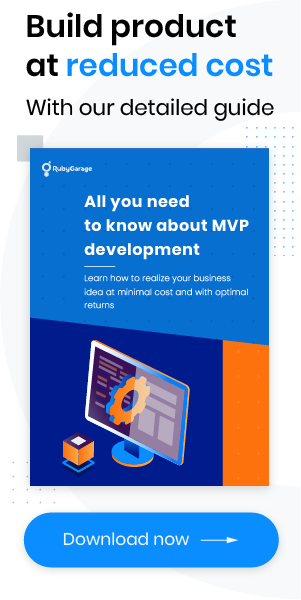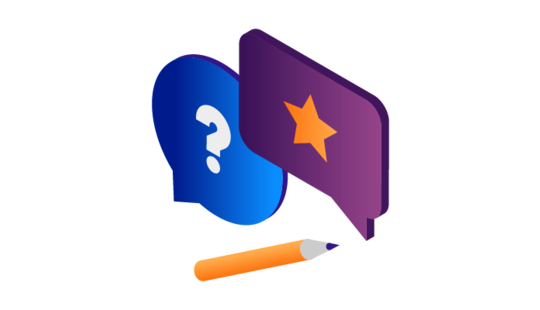-
Product Management
Software Testing
Technology Consulting
-
Multi-Vendor Marketplace
Online StoreCreate an online store with unique design and features at minimal cost using our MarketAge solutionCustom MarketplaceGet a unique, scalable, and cost-effective online marketplace with minimum time to marketTelemedicine SoftwareGet a cost-efficient, HIPAA-compliant telemedicine solution tailored to your facility's requirementsChat AppGet a customizable chat solution to connect users across multiple apps and platformsCustom Booking SystemImprove your business operations and expand to new markets with our appointment booking solutionVideo ConferencingAdjust our video conferencing solution for your business needsFor EnterpriseScale, automate, and improve business processes in your enterprise with our custom software solutionsFor StartupsTurn your startup ideas into viable, value-driven, and commercially successful software solutions -
-
- Case Studies
- Blog
What is a Minimum Viable Product
Building a startup is hard. You have to come up with a great product idea, make the product, and invest in marketing to deliver the product to the market. This is the classic startup strategy.
However, experienced ‘startuppers’ might object and say that building a product isn’t necessary. Surprisingly, it’s true: successful products like Dropbox and Pebble hadn’t yet built their products when they started receiving glowing feedback and pre-orders!
If you want to replicate the success of Dropbox and Pebble, you need to think about making an MVP (Minimum Viable Product) before you launch a full-fledged solution. Interested? Let’s find out more about minimum viable product examples.
What is a minimum viable product in 2019? A brief overview.
Back in 2011, Eric Ries released his bestselling book The Lean Startup about his experience building startups. This book not only impacted the whole startup industry, but also introduced concepts including the MVP, A/B testing, Agile principles, and continuous software deployment.
An MVP product is a product with only a basic set of features, released in order to test a new business idea and gauge people’s reactions. The idea of an MVP is to get your audience’s feedback first – before releasing a full-fledged product. MVPs can help you avoid failures and large capital losses.
Even though the concept of a minimum viable product might seem simple, some companies still misunderstand the idea of an MVP. Instead of making an initial version of their product with simplified functionality, companies either make an initial product that’s too complicated or cut out product’s key functions. An MVP should deliver the very essence of a product in its most basic form.
Today, due to the wide variety of products and services on the market, minimum viable products can differ quite a lot. Let’s speak in detail about the most prominent types of MVPs.
Piecemeal MVP
A piecemeal MVP is a smart way to introduce a product to customers by investing a minimum amount of money (or even nothing) in a product. The idea of a piecemeal MVP is to use existing tools and solutions to deliver your product or service. A piecemeal MVP literally consists of components from multiple sources which are put together to create the foundation for your product. For example, if you build a wedding dress rental marketplace, you might take advantage of popular marketplace platforms like Sharetribe and Marketplacer instead of building your own marketplace from scratch.
A classic example of a piecemeal MVP is Groupon, an American marketplace that connects customers with local retailers, travel agencies, grocers, etc. Groupon’s raison d'être is their so-called “deals,” which are available at attractive prices for one day only, and can be activated only after being purchased by specific number of people. After you purchase a Groupon deal, you receive an automatically generated PDF file with a QR code which allows you to get a discount.
Now that Groupon is a large corporation backed by teams of developers, all this sounds quite easy to implement. However, at the beginning, things were different. Originally, Groupon’s co-founder Andrew Mason came up with Point ‒ a platform where people could exchange services. Unfortunately, the project didn’t survive the 2008 global economic crisis, which disrupted credit markets and caused the decline of many businesses. So, Groupon co-founders Andrew Mason and Eric Lefkofsky came up with the idea to establish a platform with distinctive features: their service would promote local merchants only, and their deals would be available only for a limited period of time.
The Groupon’s MVP was powered by third-party resources since its co-founders didn’t expect to get any revenue from their project. Instead of building a content management system from scratch, Groupon was run on Wordpress. This is how Andrew Mason explains their experience:
All we did was we took a WordPress Blog and we skimmed it to say Groupon and then every day we would do a new post with the points embedded. It was totally ghetto. We would sell t-shirts on the first version of Groupon. We’d say in the right up, ‘This t-shirt will come in the color red, size large. If you want a different color or size, email that to us.’
After people bought deals, it was necessary to generate PDF files with coupons and send them to the clients. Groupon used FileMaker to generate PDF versions of coupons, and used Apple Mail to automate their email delivery. Groupon wasn’t a self-sufficient product when it launched, which proves that you don’t have to try building a complete scalable product from the very start. Instead of designing a system with complicated algorithms and logic, Groupon’s founders concentrated on making sure their idea was viable and that people liked it. Validate your idea first and scale it later.
Concierge MVP
Let’s imagine that we want to launch a new beauty-box service which sends samples of cosmetic products based on your age and skin type. What kind of MVP should we create for this service?
Probably, an effective solution would be to find people willing to test your service and start by analyzing data and selecting samples by hand. Once you’ve validated your idea, you can then build an application that collects people’s responses, analyzes the data, and selects matching products automatically. This type of MVP is called a “Concierge MVP,” because you validate your business idea by first providing services manually.
One of the most-cited and famous examples of a product that was initially launched with a concierge MVP is Food on the Table. Food on the Table is a mobile application that collects your food preferences and then suggests recipes and grocery stores with the best deals to help you cook tasty and cheap dishes. In 2009, Manuel Rosso, Food on the Table’s founder, had no mobile application or website for his service. But Manuel did amazing work to make sure that his startup idea was valuable for customers. First, Manuel found people willing to participate in his experiment. Then, he interviewed these participants and learned their food preferences and their budgets. After that, he manually compiled shopping lists, selected recipes and collected coupons from grocery stores to deliver his Food on the Table product. Manuel Rosso provided an exclusive concierge service which later transformed into a successful business that now helps thousands of people shop wisely and helps grocery stores market themselves effectively.
A concierge MVP is a great way to get to know your customers and validate your business idea. Because you provide the service manually and analyze your audience, this type of MVP allows you to pivot easily if you find out that customers actually want a different product.

Wizard of Oz MVP
While a Concierge MVP concentrates on delivering an experience powered by real people – and doesn’t hide the fact that the product isn’t finished yet – a ‘Wizard of Oz’ MVP focuses on creating the impression that your product is the real deal when in reality it’s actually still under development. ‘Wizard of Oz’-type MVPs are sometimes called “Manual-first MVPs” or “Flintstoning MVPs.”
The best example of a Wizard of Oz MVP is Zappos, whose founder Nick Swinmurn took pictures of shoes at brick-and-mortar stores and posted them on the internet to figure out if people wanted to buy shoes without trying them on. Today, we know the result of Nick’s trick: Zappos is a globally-recognized company with an impressive billion dollars in yearly revenue, and was acquired by Amazon for $880 million.
A Wizard of Oz MVP is a great way to test a startup that provides services of any kind: from catering to flower delivery. While your product seems full-featured from the outside, you’re behind the scenes pulling all the strings. This lets you work directly with your clients and analyze their behaviors and preferences. Arram Sabeti, CEO of ZeroCater, started with a classical Wizard of Oz MVP to launch his catering service for corporations. Aaram’s first job was as Community manager at Justin.tv; and among other responsibilities, he organized food delivery for employees. Although this sounds easy ‒ call a local restaurant or go to their website and place an order ‒ ordering food was one of the most tiresome chores Aaram had to do. Soon, Aaram realized that managing corporate meals could be a great startup idea. In the very beginning, ZeroCater operated in a spreadsheet filled in by Aaram:
The beginning was the hardest, when only a few customers stood between me and not making rent, but a year went by and the company grew. The spreadsheet I used for scheduling grew to five hundred columns and the processes I had in place started to break. Billing grew to take 20 hours a week.
Even though ZeroCater took significant resources and effort to build, it was eventually funded by Y Combinator. With a $1.5 million investment, today ZeroCater’s revenue has reached $100 million. Pretty impressive for a startup launched without any technical base to start!
A successful startup requires MVP. Would-be businesses build MVPs in order to launch a product with minimal investment, hedge against losses, and validate their startup ideas. Prosperous companies like Dropbox and Uber have started as MVPs. These examples prove that you should first care about your customers and make sure they like your product; technical details matter only after your product is demanded by a large audience.











